Our plan was to take the #7 bus at 3:34 PM and then transfer to the #5 bus at 3:54 PM. We waited at the bus stop outside of Knowlton Hall to catch the #7. Here, we sat on a bench with a shelter  while we waited. It was a frigid day, so this somewhat helped to keep the cold wind out. The sidewalk was also clean and wide; there was a lot of room for people to stand waiting all while people could pass. The #7 arrived a few minutes late. Once we got on, the driver greeted us kindly. The bus appeared to be in a suitable condition with some signs of use. The overall environment was acceptable. The lights were dimmed, the bus was clean, and the other passengers kept to themselves. The stops were regularly announced over a loudspeaker, and the time, date, and next stop were also announced and shown on an LED screen at the front of the bus.
while we waited. It was a frigid day, so this somewhat helped to keep the cold wind out. The sidewalk was also clean and wide; there was a lot of room for people to stand waiting all while people could pass. The #7 arrived a few minutes late. Once we got on, the driver greeted us kindly. The bus appeared to be in a suitable condition with some signs of use. The overall environment was acceptable. The lights were dimmed, the bus was clean, and the other passengers kept to themselves. The stops were regularly announced over a loudspeaker, and the time, date, and next stop were also announced and shown on an LED screen at the front of the bus.
 Once we got off of the #7, we had to cross residential roads (Neil Avenue) in order to get to our transfer stop. There was no cross walk and the roads were fairly busy. At this bus stop, we had no place to sit. There was only a sign stating that the #5 stopped there. Here, we waited until the bus arrived at 3:54 PM. This bus was slightly cleaner than the #7, but the driver didn’t greet us as nicely as the first; it was also much smaller and busier. The bus was quiet and became less and less busy as we went on. We rode this for awhile until the driver told us that we would have to get off so that she could go into First Community Village to pick up passengers; we weren’t allowed in because this area was not open for the public.
Once we got off of the #7, we had to cross residential roads (Neil Avenue) in order to get to our transfer stop. There was no cross walk and the roads were fairly busy. At this bus stop, we had no place to sit. There was only a sign stating that the #5 stopped there. Here, we waited until the bus arrived at 3:54 PM. This bus was slightly cleaner than the #7, but the driver didn’t greet us as nicely as the first; it was also much smaller and busier. The bus was quiet and became less and less busy as we went on. We rode this for awhile until the driver told us that we would have to get off so that she could go into First Community Village to pick up passengers; we weren’t allowed in because this area was not open for the public.
At this stop, there was no sidewalk and no bench. The stop going back the other way was initially hard to spot, and was on the private drive to the retirement village. We all had to stand in the cold for 15 to 20 minutes. The same bus came out of the assisted living home and picked us up again.
By this time, we realized that we had planned to get on the wrong bus. Instead of
going to our required destination, we had only gone about four miles. We tossed around the idea of getting off of this bus and finding the right one to get on, but we eventually decided that we wouldn’t make in there and back in time. We chalked this mistake up to the fact that the COTA system was difficult to understand. The website itself warns potential passengers that its information may not be correct, and that they should check Google maps for updated information. The lettering system of the buses also doesn’t make sense unless you know exactly which bus goes where.
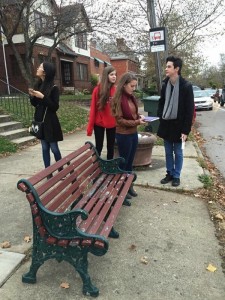 We then stopped again near where we stopped for our transfer to the #5 bus. We had a bench to sit on, but it was very close to the road with no curb. The sidewalk was also narrow. There were two buses that came to this stop; the #7 and the #18. We understood that both went back to campus, so we simply waited for the first one that came, which ended up being the #18. Like the #7, this bus was in acceptable condition with some signs of regular use.
We then stopped again near where we stopped for our transfer to the #5 bus. We had a bench to sit on, but it was very close to the road with no curb. The sidewalk was also narrow. There were two buses that came to this stop; the #7 and the #18. We understood that both went back to campus, so we simply waited for the first one that came, which ended up being the #18. Like the #7, this bus was in acceptable condition with some signs of regular use.
Overall, our trip on the bus wasn’t bad, but required much planning and forethought. You had to look up the timetables online because there are none that we found at bus stops, the Student Union, or any place a university connected to a city bus system would typically have them. In addition, COTA’s website mislead and confused us as we accidentally planned a trip to the incorrect Giant Eagle Market District. However, we did eventually realize that we had taken the wrong route because of the regular announcements of each stop’s location. The other passengers acted similarly throughout the evening, mostly keeping to themselves, and the drivers all greeted us, but to different degrees. Additionally, the equipment throughout our transfers all appeared to be in good condition with acceptable signs of use. These aspects allowed us to feel as though we were in a safe environment, allowing for a pleasant trip that took exactly 1 hour and 16 minutes on the bus overlooking the trouble we had with finding the correct route.




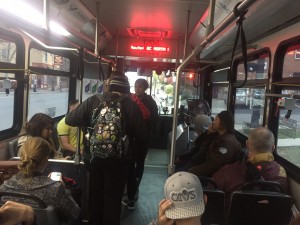



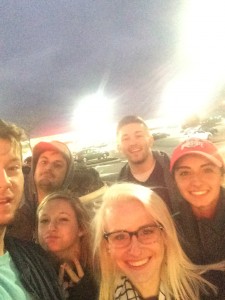

 The Urban Avengers’ trek began at the COTA bus stop on High Street (heading south) near 18th Avenue. While this stop was certainly not chock-full of amenities, it did provide two large, sturdy trash cans.
The Urban Avengers’ trek began at the COTA bus stop on High Street (heading south) near 18th Avenue. While this stop was certainly not chock-full of amenities, it did provide two large, sturdy trash cans.

 So we waited in a *COTA shelter at the southeast corner of Broad and High for the next #10, scheduled for 4:31 (actual arrival 4:33).
So we waited in a *COTA shelter at the southeast corner of Broad and High for the next #10, scheduled for 4:31 (actual arrival 4:33).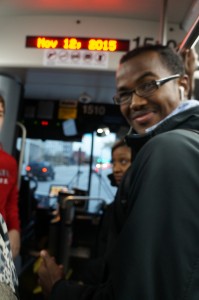 The rest of us were prepared to attempt the entire trip, but when our bus was continually slowed by several red lights and another handicapped passenger situation, we knew we were looking at a 5:00 pm arrival at our destination (at best), and therefore abandoned the Conservatory destination.
The rest of us were prepared to attempt the entire trip, but when our bus was continually slowed by several red lights and another handicapped passenger situation, we knew we were looking at a 5:00 pm arrival at our destination (at best), and therefore abandoned the Conservatory destination.
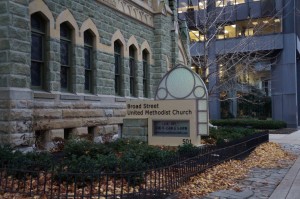 Rhoda Du, Evan Hertzog, Daniel Cirino, Nathan Vale and Gina Scarver
Rhoda Du, Evan Hertzog, Daniel Cirino, Nathan Vale and Gina Scarver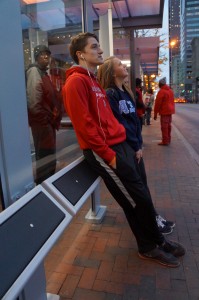 Our feet were literally sticking to the sidewalks in and around the several shelters. There were several shelters, which we did not enter as they were crowded. We did, however, enjoy the slanted horizontal “resting/leaning pads” which are fastened to the front of the shelters, this helped with standing. This stop, overall, was very disappointing and made for an uncomfortable wait, largely due to the smell and dirty conditions.
Our feet were literally sticking to the sidewalks in and around the several shelters. There were several shelters, which we did not enter as they were crowded. We did, however, enjoy the slanted horizontal “resting/leaning pads” which are fastened to the front of the shelters, this helped with standing. This stop, overall, was very disappointing and made for an uncomfortable wait, largely due to the smell and dirty conditions. It is our belief that had we continued to the Conservatory as originally planned, we would not have arrived back at Woodruff & High until possibly well after 6:00 pm; so while we did not want to abandon the destination, we felt it was the correct choice based on timing.
It is our belief that had we continued to the Conservatory as originally planned, we would not have arrived back at Woodruff & High until possibly well after 6:00 pm; so while we did not want to abandon the destination, we felt it was the correct choice based on timing.